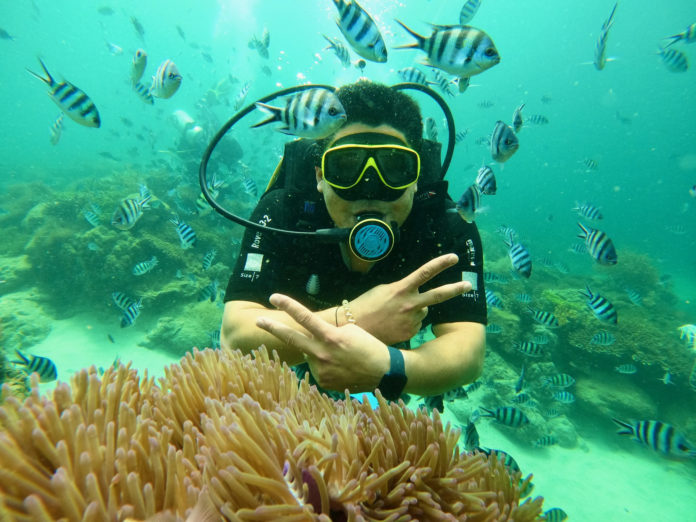According to the survey, the coral coverage in the northwestern and northern regions of Hon Mun Island was found to be between 30 percent and 50 percent by the end of 2023. The predominant coral species in these areas are Porites and Millepora dichotoma.
In the western area of the island, there is a thriving population of coral seedlings on fragmented coral substrates, with the Acropora species being the most prevalent.
Both regions experienced significant damage to their coral reefs due to a storm in December 2021.
Prior to this, 17 businesses were authorized to offer scuba diving services at six different locations in the waters surrounding Hon Mun Island. Hon Mun Island is situated more than 10 kilometers from the coast and covers an area of 160 square kilometers.
As one of the most picturesque islands near the popular tourist destination of Nha Trang, Hon Mun Island was once home to diverse coral reefs and a rich marine ecosystem.
In June 2022, the management board of Nha Trang Bay noticed a significant decline in coral reefs near Hon Mun Island. In response, local authorities temporarily suspended diving activities in this area to allow for coral reef restoration.
During the suspension, the bay management board established a temporary diving site in the Hon Rom Island area. This site is still in use today while efforts to protect the marine environment and coral reefs continue.
Since the end of 2023, the management board has implemented regulations banning the use of single-use plastic items and non-biodegradable plastic bags at Nha Trang tourist wharf.
In addition, to support scuba diving businesses in Nha Trang Bay, the board has proposed the establishment of four additional pilot diving spots beyond Hon Rom Island. These spots include the northern region of Hon Rua Island, the artificial reef zone in Vinh Hoa Ward, the northeast part of Tri Nguyen Island, and the water area between Bai Tranh and Bai Soi, which is located east of Tri Nguyen.
However, the proposal is currently under review by the relevant authorities.
|
|
| A diver collects trash during a scuba dive in Nha Trang Bay, Nha Trang City, Khanh Hoa Province, south-central Vietnam. Photo: Nguyen Duc / Tuoi Tre |
Enterprises and tourists working together
Companies specializing in organizing scuba diving activities, like Viet Asian Nha Trang Joint Stock Company, are actively involved in coral reef conservation.
Nguyen Huy Han, the director of Viet Asian Nha Trang, explains that his company always instructs divers not to touch or disturb the coral, as even minimal contact can damage or break coral branches.
Tourists are advised not to collect or touch dead or discolored coral, as these serve as habitats for marine creatures. Instead, they are encouraged to admire and photograph coral reefs from a distance of 30-50 centimeters.
Each dive usually lasts between 15 and 20 minutes and involves one to three people.
“Tourists participating in scuba diving or underwater exploration must be accompanied by a guide who provides instructions on movement to prevent damage to coral reefs,” emphasizes Han.
“When guiding divers to shallow-water coral reefs by boat, we often anchor in sandy areas, avoiding those with coral in the bottoms.”
The company also discourages the use of cosmetics containing harmful substances like oxybenzone and avobenzone, as these can bleach coral and harm marine life.
Besides scuba diving, many tour operators also engage their divers in activities such as cleaning up trash, removing fishing nets from coral reefs, and protecting marine life.
Nguyen Van Duc, an experienced diver in Nha Trang, says, “Combining scuba diving with clean-up activities helps participants develop a greater appreciation for the marine environment.”
“Witnessing the negative impact of fishing nets and litter on coral reefs raises awareness about marine conservation.
“During these trips, we also capture animals that are harmful to corals, such as sea urchins.”
I-RESORT NHA TRANG
Located closed to Nha Trang, Khanh Hoa Province, I-Resort Nha Trang is a peaceful space with mineral mud bath services that help tourists eliminate stress from their daily lives and feel a deep sense of calm and total relaxation.
Diving for Pearl Oysters on Tam Islet
Tam Islet is one of the four most beautiful islets in Nha Trang with a diverse maritime eco-system. The islet is an ideal place for swimming and diving to behold colourful coral reefs and see pearl oysters which are raised in the sea. Recently, the Provincial People’s Committee of Khanh Hoa instructed the Giang Gia Pearl Company and the Hon Tam Tourists Area to organize dive tours for pearl oysters.










